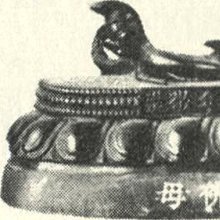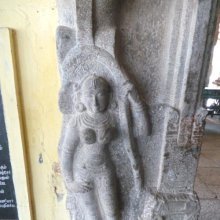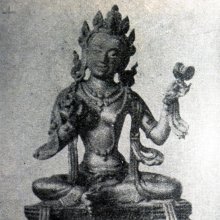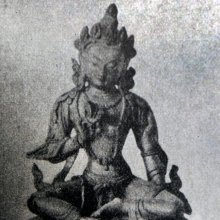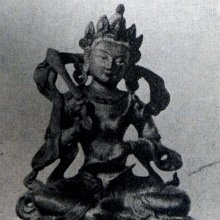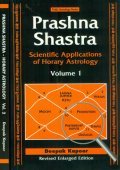Kanya, Kanyā: 27 definitions
Introduction:
Kanya means something in Buddhism, Pali, Hinduism, Sanskrit, Jainism, Prakrit, Marathi, Hindi, biology. If you want to know the exact meaning, history, etymology or English translation of this term then check out the descriptions on this page. Add your comment or reference to a book if you want to contribute to this summary article.
Images (photo gallery)
(+1 more images available)
In Hinduism
Ayurveda (science of life)
Rasashastra (Alchemy and Herbo-Mineral preparations)
Source: Wisdom Library: Rasa-śāstra1) Kanyā (कन्या):—One of the sixty-eight Siddhauṣadhi, as per Rasaśāstra texts (rasa literature). These drugs give siddhi (success) in mercurial operations. Even so, they are more powerful than rasa (mercury) itself. These may perform all the kāryas (‘effects’) and grant dehasiddhi (‘perfection of body’) and lohasiddhi (‘transmutation of base metals’) both.
2) Kanyā (कन्या).—The name of a plant, possibly identified with Aloe indica. It is used in various alchemical processess related to mercury (rasa or liṅga), according to the Rasārṇavakalpa (11th-century work dealing with Rasaśāstra).
Kalpa (Formulas, Drug prescriptions and other Medicinal preparations)
Source: Shodhganga: Edition translation and critical study of yogasarasamgrahaKanyā (कन्या) is another name for “Kumārī” and is dealt with in the 15th-century Yogasārasaṅgraha (Yogasara-saṅgraha) by Vāsudeva: an unpublished Keralite work representing an Ayurvedic compendium of medicinal recipes. The Yogasārasaṃgraha [mentioning kanyā] deals with entire recipes in the route of administration, and thus deals with the knowledge of pharmacy (bhaiṣajya-kalpanā) which is a branch of pharmacology (dravyaguṇa).
Nighantu (Synonyms and Characteristics of Drugs and technical terms)
Source: WorldCat: Rāj nighaṇṭuKanyā (कन्या) is another name for Gṛhakanyā, a medicinal plant commonly identified with Aloe vera var. chinensis Baker from the Asphodelaceae family of flowering plants, according to verse 5.47-49 of the 13th-century Raj Nighantu or Rājanighaṇṭu. The fifth chapter (parpaṭādi-varga) of this book enumerates sixty varieties of smaller plants (kṣudra-kṣupa). Together with the names Kanyā and Gṛhakanyā, there are a total of twenty-one Sanskrit synonyms identified for this plant.

Āyurveda (आयुर्वेद, ayurveda) is a branch of Indian science dealing with medicine, herbalism, taxology, anatomy, surgery, alchemy and related topics. Traditional practice of Āyurveda in ancient India dates back to at least the first millenium BC. Literature is commonly written in Sanskrit using various poetic metres.
Shaktism (Shakta philosophy)
Source: Wisdom Library: ŚāktismKanyā (कन्या, “the virgin”).—One of the names of the Goddess, Devī, who is regarded as the female principle of the divine; the embodiement of the energies of the Gods.

Shakta (शाक्त, śākta) or Shaktism (śāktism) represents a tradition of Hinduism where the Goddess (Devi) is revered and worshipped. Shakta literature includes a range of scriptures, including various Agamas and Tantras, although its roots may be traced back to the Vedas.
Purana and Itihasa (epic history)
Source: archive.org: Shiva Purana - English Translation1) Kanyā (कन्या) is the name of a sacred river as mentioned in the Śivapurāṇa 1.12, “somehow men must strive to find a residence in a holy centre. On the shores of the ocean in the confluence of hundreds of rivers there are many such holy centres (puṇyakṣetra or tīrtha) and temples. [...] By residing on the banks of the auspicious rivers Sarasvatī, Pampā, Kanyā and Śvetanadī one shall attain Indraloka”.
Note: The country situated on the bank of this river is sacred to Śiva. Cf Skanda-purāṇa i.iii u 2. 7-19.
2) Kanyā (कन्या) refers to a “daughter”, which is mentioned as obtainable through the worship of Śiva, according to the Śivapurāṇa 2.1.14:—“[...] a person afflicted by ailments (rogagrasta) shall worship half that number [for details, see text]. A person desiring a daughter (kanya-kāma) shall worship half that number”.
Source: Cologne Digital Sanskrit Dictionaries: The Purana Index1a) Kanyā (कन्या).—rāśi and month puraṭṭāśi.*
- * Vāyu-purāṇa 105. 47.
1b) Daughter of Kardama and wife of Priyavrata; mother of two daughters and ten sons.*
- * Viṣṇu-purāṇa II. 1. 5.
1c) Shrine of, south of Malaya {??}ills, visited by Balarāma.*
- * Bhāgavata-purāṇa X. 79. 17.

The Purana (पुराण, purāṇas) refers to Sanskrit literature preserving ancient India’s vast cultural history, including historical legends, religious ceremonies, various arts and sciences. The eighteen mahapuranas total over 400,000 shlokas (metrical couplets) and date to at least several centuries BCE.
Vastushastra (architecture)
Source: Wisdom Library: Vāstu-śāstraKanyā (कन्या) corresponds with the Virgo zodiac sign and refers to the sixth of twelve rāśi (zodiacal sign), according to the Mānasāra. Rāśi is one of the three alternative principles, besides the six āyādiṣaḍvarga, used to constitute the “horoscope” of an architectural or iconographic object. Their application is intended to “verify” the measurements of the architectural and iconographic object against the dictates of astrology that lay out the conditions of auspiciousness.
The particular rāśi (e.g., kanyā) of all architectural and iconographic objects (settlement, building, image) must be calculated and ascertained. This process is based on the principle of the remainder. An arithmetical formula to be used in each case is stipulated, which engages one of the basic dimensions of the object (breadth, length, or perimeter/circumference). All twelve rāśis, except the eighth (vṛścika) are auspicious.

Vastushastra (वास्तुशास्त्र, vāstuśāstra) refers to the ancient Indian science (shastra) of architecture (vastu), dealing with topics such architecture, sculpture, town-building, fort building and various other constructions. Vastu also deals with the philosophy of the architectural relation with the cosmic universe.
Chandas (prosody, study of Sanskrit metres)
Source: Shodhganga: a concise history of Sanskrit Chanda literatureKanyā (कन्या) refers to one of the 135 metres (chandas) mentioned by Nañjuṇḍa (1794-1868 C.E.) in his Vṛttaratnāvalī. Nañjuṇḍa was a poet of both Kannada and Sanskrit literature flourished in the court of the famous Kṛṣṇarāja Woḍeyar of Mysore. He introduces the names of these metres (e.g., Kanyā) in 20 verses.
While describing the metre kanyā, Hariśaṅkara (of Gauḍavaṃśa) in his Vṛttamuktāvalī defines the characteristics of the metre as: “where four ra’s (ra-gaṇas) are found in each pāda of a verse, that metre is called as kanyā.

Chandas (छन्दस्) refers to Sanskrit prosody and represents one of the six Vedangas (auxiliary disciplines belonging to the study of the Vedas). The science of prosody (chandas-shastra) focusses on the study of the poetic meters such as the commonly known twenty-six metres mentioned by Pingalas.
Vaishnavism (Vaishava dharma)
Source: Pure Bhakti: Arcana-dipika - 3rd EditionKanyā (कन्या) corresponds to “virgo” (mid September to mid October) and refers to one of the zodiac signs (rāśī) in the Vedic calendar.—Rāśī refers to the different signs of the zodiac through which the sun travels. For precise dates, please refer to a Vedic calendar. In accordance with the zodiac sign the sun is situated in, one would utter [for example, kanyā-rāśī sthite bhāskare]

Vaishnava (वैष्णव, vaiṣṇava) or vaishnavism (vaiṣṇavism) represents a tradition of Hinduism worshipping Vishnu as the supreme Lord. Similar to the Shaktism and Shaivism traditions, Vaishnavism also developed as an individual movement, famous for its exposition of the dashavatara (‘ten avatars of Vishnu’).
Shaivism (Shaiva philosophy)
Source: SOAS University of London: Protective Rites in the Netra TantraKanyā (कन्या) refers to a “girl”, according to the Netratantra of Kṣemarāja: a Śaiva text from the 9th century in which Śiva (Bhairava) teaches Pārvatī topics such as metaphysics, cosmology, and soteriology.—Accordingly, [verse 6.46-48ab]—“Lifespan, strength, victory, loveliness, firmness, wisdom, a beautiful form, and good fortune, the highest kingdom for kings, all of these arise. Tormented by pain, [the ritual beneficiary] will be without pain; someone marked by disease will be without disease; a barren woman [will] obtain a son; a girl (kanyā) [will] attract a husband. [The beneficiary] will surely attain whatever pleasures he wants”.

Shaiva (शैव, śaiva) or Shaivism (śaivism) represents a tradition of Hinduism worshiping Shiva as the supreme being. Closely related to Shaktism, Shaiva literature includes a range of scriptures, including Tantras, while the root of this tradition may be traced back to the ancient Vedas.
In Buddhism
Tibetan Buddhism (Vajrayana or tantric Buddhism)
Source: Wisdom Library: Tibetan BuddhismKanyā (कन्या) is the name of a Rāśi (zodiac sign) mentioned as attending the teachings in the 6th century Mañjuśrīmūlakalpa: one of the largest Kriyā Tantras devoted to Mañjuśrī (the Bodhisattva of wisdom) representing an encyclopedia of knowledge primarily concerned with ritualistic elements in Buddhism. The teachings in this text originate from Mañjuśrī and were taught to and by Buddha Śākyamuni in the presence of a large audience (including Kanyā).

Tibetan Buddhism includes schools such as Nyingma, Kadampa, Kagyu and Gelug. Their primary canon of literature is divided in two broad categories: The Kangyur, which consists of Buddha’s words, and the Tengyur, which includes commentaries from various sources. Esotericism and tantra techniques (vajrayāna) are collected indepently.
Mahayana (major branch of Buddhism)
Source: academia.edu: A Study and Translation of the GaganagañjaparipṛcchāKanyā (कन्या) refers to “girls”, according to the Gaganagañjaparipṛcchā: the eighth chapter of the Mahāsaṃnipāta (a collection of Mahāyāna Buddhist Sūtras).—Accordingly: “Then the Bodhisattva Apāyajaha addressed himself to the Bodhisattva Gaganagañja: ‘Son of good family, please pacify three evil existences’. [...] Then, the rain of gifts, such as flowers, garlands, incenses, unguents, aromatic powers, religious robes, parasols, banners, pennons, five kinds of musical instruments, songs, male servants, female servants, wives, boys, girls (kanyā), female attendants, horses, elephants, [...] poured down from the open space. [...]”.
Source: De Gruyter: A Buddhist Ritual Manual on AgricultureKanyā (कन्या) refers to “(Nāga) girls”, according to the Vajratuṇḍasamayakalparāja, an ancient Buddhist ritual manual on agriculture from the 5th-century (or earlier), containing various instructions for the Sangha to provide agriculture-related services to laypeople including rain-making, weather control and crop protection.—Accordingly, [as the Bhagavān teaches various Nāga-enchantments], “[...] The image of five Nāga girls (nāga-kanyā) should be placed in a secret place. Flowers and incense should be offered. It should be kept in a calm place, without having been perceived; nobody should be offered a sight of it. It should be covered with a clean cloth. If there is need, it should be struck with mustard seeds enchanted 108 times. It will accomplish all enterprises. [...]”

Mahayana (महायान, mahāyāna) is a major branch of Buddhism focusing on the path of a Bodhisattva (spiritual aspirants/ enlightened beings). Extant literature is vast and primarely composed in the Sanskrit language. There are many sūtras of which some of the earliest are the various Prajñāpāramitā sūtras.
In Jainism
General definition (in Jainism)
Source: Singhi Jain Series: Ratnaprabha-suri’s Kuvalayamala-kathaKanyā (कन्या) or Aṣṭakanyā refers to the “(eight) auspicious girls” (representing the eight celestial nymphs of Indra’s heaven), according to Uddyotanasūri in his 8th-century Kuvalayamālā (a Prakrit Campū, similar to Kāvya poetry).—Page 93.17-8: There is a list of Eight auspicious girls holding respectively sprouted water-jars, fan-palm, fly-whisk, parasol, mirror, mṛdaṅga, harp, drum and cloth and ornaments. These were regarded as eight celestial nymphs of Indra’s heaven and frequently referred in literature as aṣṭa-kanyā or sabhā-kanyā. They are mentioned as forming part of the articles collected for Rāma’s coronation (Ayodhyā-kāṇḍa 15.8) and that of Sugrīva where their number became sixteen. King Yudhiṣṭhira looked at these auspicious maidens as amongst the objects seen by him every morning. These were regarded as auspicious to be seen before starting on a journey.

Jainism is an Indian religion of Dharma whose doctrine revolves around harmlessness (ahimsa) towards every living being. The two major branches (Digambara and Svetambara) of Jainism stimulate self-control (or, shramana, ‘self-reliance’) and spiritual development through a path of peace for the soul to progess to the ultimate goal.
Biology (plants and animals)
Source: Google Books: CRC World Dictionary (Regional names)1) Kanya in India is the name of a plant defined with Aloe vera in various botanical sources. This page contains potential references in Ayurveda, modern medicine, and other folk traditions or local practices It has the synonym Aloe perfoliata L. var. barbadensis (Mill.) Aiton (among others).
2) Kanya is also identified with Echinops echinatus.
3) Kanya in Zaire is also identified with Trichilia gilletii.
Example references for further research on medicinal uses or toxicity (see latin names for full list):
· Nomenclator Botanicus (1840)
· Flora Aegyptiaco-Arabica (1775)
· Tabl. École Bot. (1804)
· Transactions of the Linnean Society of London, Bot. (1878)
· Fl. Mesoamer. (1994)
· Descr. Pl. Anim. (1767)
If you are looking for specific details regarding Kanya, for example diet and recipes, extract dosage, side effects, chemical composition, health benefits, pregnancy safety, have a look at these references.

This sections includes definitions from the five kingdoms of living things: Animals, Plants, Fungi, Protists and Monera. It will include both the official binomial nomenclature (scientific names usually in Latin) as well as regional spellings and variants.
Languages of India and abroad
Marathi-English dictionary
Source: DDSA: The Molesworth Marathi and English Dictionarykanyā (कन्या).—f (S) An unmarried girl about eight years of age; a girl gen. 2 The sign Virgo.
Source: DDSA: The Aryabhusan school dictionary, Marathi-Englishkanyā (कन्या).—f A girl. kanyā f The small. zodiacal sign Virgo.
Marathi is an Indo-European language having over 70 million native speakers people in (predominantly) Maharashtra India. Marathi, like many other Indo-Aryan languages, evolved from early forms of Prakrit, which itself is a subset of Sanskrit, one of the most ancient languages of the world.
Sanskrit dictionary
Source: DDSA: The practical Sanskrit-English dictionaryKanyā (कन्या).—[Uṇādi-sūtra 4.111]
1) An unmarried girl or daughter; R.1.51.2.1,3.33; Manusmṛti 1.8.
2) A girl ten years old.
3) A virgin, maiden; Manusmṛti 8.367,3.33.
4) A woman in general.
5) The sixth sign of the zodiac, i. e. Virgo.
6) Name of Durgā; Mahābhārata (Bombay) 3.
7) Large cardamoms.
Source: Cologne Digital Sanskrit Dictionaries: Shabda-Sagara Sanskrit-English DictionaryKanyā (कन्या).—f.
(-nyā) 1. A girl nine years old, a virgin. 2. A name of Durga. 3. The sign of the zodiac, Virgo. 4. The socotrine aloe (Aloes perfoliata.) 6. Large cardamoms. 7. A species of metre of four lines, with four syllables in each. 3. A parasite plant. E. kan to shine, Unadi affix yak, fem. ṭāp.
Source: Cologne Digital Sanskrit Dictionaries: Benfey Sanskrit-English DictionaryKanyā (कन्या).— (akin to kanīyaṃs), f. 1. A girl, [Nala] 1, 8. 2. A virgin, [Mānavadharmaśāstra] 8, 367. 3. A daughter, [Mānavadharmaśāstra] 9, 71.
Source: Cologne Digital Sanskrit Dictionaries: Cappeller Sanskrit-English DictionaryKanya (कन्य).—[adjective] the smallest; [feminine] kanyā girl, maid, daughter, the Virgo in the zodiac.
Source: Cologne Digital Sanskrit Dictionaries: Monier-Williams Sanskrit-English Dictionary1) Kanya (कन्य):—[from kana] a mf(ā)n. the smallest (opposed to uttama and madhyama), [Hemādri’s Caturvarga-cintāmaṇi i, 302, 8 ff.]
2) Kanyā (कन्या):—[from kanya > kana] a f. See kanyā below;
3) Kanya (कन्य):—[from kana] cf. [Zend] kainin; [Hibernian or Irish] cain, ‘chaste, undefiled.’
4) Kanyā (कन्या):—[from kana] b f. (√kan, [Uṇādi-sūtra iv, 111]), a girl, virgin, daughter, [Ṛg-veda; Atharva-veda] etc., [Mahābhārata] etc. (kanyāṃ √dā or pra-√dā or pra-√yam or upa-√pad, [Causal] to give one’s daughter in marriage, [Manu-smṛti viii, ix]; kanyāṃ prati-√grah or √hṛ or √vah, to receive a girl in marriage, marry, [Manu-smṛti ix])
5) [v.s. ...] the sign of the zodiac Virgo, [Varāha-mihira’s Bṛhajjātaka] and, [Varāha-mihira’s Bṛhat-saṃhitā] etc.
6) [v.s. ...] the female of any animal, [Mṛcchakaṭikā]
7) [v.s. ...] Name of Durgā, [Mahābhārata iii, 8115]
8) [v.s. ...] Name of a tuberous plant growing in Kaśmīra, [Suśruta]
9) [v.s. ...] Aloe Perfoliata, [cf. Lexicographers, esp. such as amarasiṃha, halāyudha, hemacandra, etc.]
10) [v.s. ...] several other plants, [cf. Lexicographers, esp. such as amarasiṃha, halāyudha, hemacandra, etc.]
11) [v.s. ...] Name of a metre (of four lines, each of them containing four long syllables).
12) Kanya (कन्य):—b kanyaka, kanyā, etc. See p. 249, col. 1.
Source: Cologne Digital Sanskrit Dictionaries: Yates Sanskrit-English DictionaryKanyā (कन्या):—(nyā) 1. f. A girl nine years old; Durga; Virgo; an aloe; large cadamoms; a parasite.
Source: DDSA: Paia-sadda-mahannavo; a comprehensive Prakrit Hindi dictionary (S)Kanyā (कन्या) in the Sanskrit language is related to the Prakrit words: Kaṇṇa, Kaṇṇā, Kāṇiya, Jaṇhukannā.
[Sanskrit to German]
Sanskrit, also spelled संस्कृतम् (saṃskṛtam), is an ancient language of India commonly seen as the grandmother of the Indo-European language family (even English!). Closely allied with Prakrit and Pali, Sanskrit is more exhaustive in both grammar and terms and has the most extensive collection of literature in the world, greatly surpassing its sister-languages Greek and Latin.
Hindi dictionary
Source: DDSA: A practical Hindi-English dictionaryKanyā (कन्या):—(nf) a virgin; daughter; girl; ([rāśi]) virgo; ~[rāsī] possessing an effeminate disposition or temper; weakling; ~[dāna] giving away a daughter in marriage.
...
See also (Relevant definitions)
Starts with (+107): Kanya dan, Kanya kumaari, Kanya Puja, Kanya-dharma, Kanya-nganya, Kanyabhaiksha, Kanyabhaikshya, Kanyabhartar, Kanyabhartri, Kanyabhava, Kanyabrata, Kanyacala, Kanyacarita, Kanyachala, Kanyadana, Kanyadanakala, Kanyadanapaddhati, Kanyadanaprayoga, Kanyadanasamkalpa, Kanyadanavidhi.
Ends with (+68): Abdhikanya, Abhirakanya, Adrikanya, Akanya, Anritukanya, Ashtakanya, Bhadrakanya, Bhagirathakanya, Bhatabhonkanya, Bhojakanya, Bhujamgakanya, Bhujangakanya, Brahmakanya, Carukanya, Charukanya, Dakshakanya, Devakanya, Dikkanya, Ekanya, Gajakanya.
Full-text (+422): Kanna, Kanyavedin, Kanyasamudbhava, Kanyadosha, Kanyadana, Kanyakubja, Kaṇiya, Grihakanya, Kanyadushana, Kanyarama, Akanya, Kanyata, Kanyamaya, Kanyakumari, Anritukanya, Gopakanya, Kanyadushaka, Luto-na-kanyai, Kanyabhartri, Kanyaka.
Relevant text
Search found 90 books and stories containing Kanya, Kanyā, Kāṇya, Kanyaa; (plurals include: Kanyas, Kanyās, Kāṇyas, Kanyaas). You can also click to the full overview containing English textual excerpts. Below are direct links for the most relevant articles:
Garga Samhita (English) (by Danavir Goswami)
Verse 4.6.30 < [Chapter 6 - The Story of the Ayodhyā Women]
Verse 6.4.28 < [Chapter 4 - Journey to the City of Kuṇḍina]
Verse 8.13.20 < [Chapter 13 - A Thousand Names of Lord Balarāma]
Rig Veda (translation and commentary) (by H. H. Wilson)
Satirical works of Kshemendra (study) (by Arpana Devi)
5.20. The Wife of the Old Man (vṛddhabhāryā) < [Chapter 5 - Kṣemendra’s objectives of Satire]
1.1. Upamā (simile) < [Chapter 4 - Literary study of the Three Satirical Works]
9.7. Summary of the Rahgharā (1916) < [Chapter 1 - Introduction]
Women in the Atharva-veda Samhita (by Pranab Jyoti Kalita)
2. Hymns to Obtain a Husband < [Chapter 2 - The Strīkarmāṇi Hymns of the Atharvaveda]
1. Woman in the Family and as a Daughter < [Chapter 3 - The Familial and Social Life of Women in the Atharvaveda]
5i. Female Education < [Chapter 3 - The Familial and Social Life of Women in the Atharvaveda]
Rasa Jala Nidhi, vol 4: Iatrochemistry (by Bhudeb Mookerjee)
Part 3 - Treatment of Piles (2): Vidhubhusana rasa < [Chapter V - Piles]
Treatment for fever (170): Chandrodaya rasa < [Chapter II - Fever (jvara)]
Part 11 - Treatment of Piles (10): Tiksna-mukha rasa < [Chapter V - Piles]
The Practice Manual of Noble Tārā Kurukullā (by Dharmachakra Translation Committee)
Chapter 1 < [Appendix - Sanskrit Text]
Related products
